Beating the Drums of War: Provoking Iran into "Firing the First Shot"
[Author's Note: SAY NO TO WAR ON IRAN, Spread the word, forward this article, post it on Facebook. Our objective at Global Research is to curb the flow of media disinformation, reverse the tide of war and restore World peace.]
Introduction
While the possibility of a war with Iran is acknowledged in US news reports, its regional and global implications are barely analyzed.
Very few people in America are aware or informed regarding the devastation and massive loss of life which would occur in the case of a US-Israeli sponsored attack on Iran.
The media is involved in a deliberate process of camouflage and distortion.
War preparations under a “Global Strike” Concept, centralized and coordinated by US Strategic Command (STRATCOM) are not front page news in comparison to the most insignificant issues of public concern, including the local level crime scene or the tabloid gossip reports on Hollywood celebrities.
The “Globalization of War” involving the hegemonic deployment of a formidable US-NATO military force in all major regions of the World is inconsequential in the eyes of the Western media.
The broader implications of this war are either trivialized or not mentioned. People are led to believe that war is part of a “humanitarian mandate” and that both Iran as well as Iran’s allies, namely China and Russia, constitute an unrelenting threat to global security and “Western democracy”.
While the most advanced weapons system are used, America’s wars are never presented as “killing operations” resulting in extensive civilian casualties.
While the incidence of “collateral damage” is acknowledged, US-led wars are heralded as an unquestionable instrument of “peace-making” and “democratization”.
This twisted notion that waging war is “a worthy cause”, becomes entrenched in the inner consciousness of millions of people. A framework of “good versus evil” overshadows an understanding of the causes and devastating consequences of war.
Within this mindset, realties as well as concepts are turned upside down. War becomes peace. The lie becomes the truth. The humanitarian mandate of the Pentagon and NATO cannot be challenged.
When “going after the bad guys”, no options can be taken off the table. An inquisitorial doctrine similar to that of the Spanish Inquisition, prevails. People are no longer allowed to think.
Iran is a country of close to 80 million people. It constitutes a major and significant regional military and economic power. It has ten percent of global oil and gas reserves, more than five times those of the United States of America.
The conquest of Iran’s oil riches is the driving force behind America’s military agenda. Iran’s oil and gas industry is the unspoken trophy of the US led war.
While the US is on a war footing, Iran has –for more than ten years– been actively developing its military capabilities in the eventuality of a US sponsored attack.
If hostilities were to break out between Iran and the Western military alliance, this could trigger a regional war extending from the Mediterranean to the Chinese border, potentially leading humanity into the realm of a World War III scenario.
The Russian government, in a recent statement, has warned the US and NATO that “should Iran get drawn into any political or military hardships, this will be a direct threat to our national security.” What this signifies is that Russia is Iran’s military ally and that Russia will act militarily if Iran is attacked.
Military Deployment
Iran is the target of US-Israel-NATO war plans.
Advanced weapons systems have been deployed.
US and allied Special Forces as well as intelligence operatives are already on the ground inside Iran. US military drones are involved in spying and reconnaissance activities.
Bunker buster B61 tactical nuclear weapons are slated to be used against Iran in retaliation for its alleged nuclear weapons program. Ironically, in the words of US Defense Secretary Leon Panetta, Iran does not possess a nuclear weapons program. “Are they trying to develop a nuclear weapon? No.”
The risk of armed hostilities between the US-Israel led coalition and Iran is, according to Israeli military analysts “dangerously close”.
There has been a massive deployment of troops which have been dispatched to the Middle East, not to mention the redeployment of US and allied troops previously stationed in Afghanistan and Iraq.
Nine thousand US troops have been dispatched to Israel to participate in what is described by the Israeli press as the largest joint air defense war exercise in Israeli history, The drill, called “Austere Challenge 12,” is scheduled to take place within the next few weeks Its stated purpose “is to test multiple Israeli and US air defense systems, especially the “Arrow” system, which the country specifically developed with help from the US to intercept Iranian missiles.”
Reports also suggest that substantial increase in the number of reservists who are being deployed to the Middle East. Reports confirm that reservist US Air Force personnel have been dispatched to military bases in South West Asia (Persian Gulf). From Minnesota, more than 120 Airmen including pilots, navigators, mechanics, etc. departed for the Middle East on January 8. Reservist US air force personnel from bases in North Carolina and Georgia “expect to deploy with their units in coming months”. (See fayobserver.com December 18, 2011)
Reserve units from the US Coastguard have also been dispatched to the Middle East.(Coast Guard Reservists Head to Middle East military.com, January 5, 2012)
From these local reports, however, it is impossible to establish the overall (net) increase of US reservists from different divisions of the US military, who have been assigned to “operation Iran war”.
Army reservists from the UK are also been sent to the Middle East.
US Troops to Israel
Israel has become a de facto US military outpost. US and Israeli command structures are being integrated, with close consultations between the Pentagon and Israel’s Ministry of Defense.
A large number of US troops will be stationed in Israel once the war games are completed. The assumption of this military deployment is the staging of a joint US-Israeli air attack on Iran. Military escalation towards a regional war is part of the military scenario:
Thousands of US troops began descending on Israel this week. … many would be staying up to the end of the year as part of the US-IDF deployment in readiness for a military engagement with Iran and its possible escalation into a regional conflict. They will be joined by a US aircraft carrier. The warplanes on its decks will fly missions with Israeli Air Force jets. The 9,000 US servicemen gathering in Israel in the coming weeks are mostly airmen, missile interceptor teams, marines, seamen, technicians and intelligence officers.
…
Tehran too is walking a taut tightrope. It is staging military’s maneuvers every few days to assuring the Iranian people that its leaders are fully prepared to defend the country against an American or Israeli strike on its national nuclear program. By this stratagem, Iran’s ground, sea and air forces are maintained constantly at top war readiness to thwart any surprise attack.
The joint US-Israeli drill will test multiple Israeli and US air defense systems against incoming missiles and rockets, according to the official communiqué. (DEBKAfile, January 6, 2012)
War Games
Missile defense and naval war games are being conducted simultaneously. US-Israeli war games –involving an impressive display of naval power– are slated to be held in the Persian Gulf. Meanwhile, Iran has announced that it will be conducting its own war games in the Persian Gulf in February.
An impressive deployment of troops and advanced military hardware is unfolding. Britain’s Royal Navy has dispatched her newest and most advanced warship, Type 45 destroyer HMS Daring, “which has a “stealth” design to help avoid detection by radar”.
Britain’s HMS Daring
Meanwhile, The Islamic Republic of Iran is also on a war footing. Iran’s Armed Forces is in an advanced stage of preparedness to defend the country’s borders as well as retaliate against a US-Israel led attack. Iran has completed a 10-day naval exercise near the Strait of Hormuz in December. It has now announced that it is planning new naval drills codenamed “The Great Prophet”, which are slated to take place in February.
Iran’s December war games involved the test firing of two long range missiles systems, including the Qadar (a powerful sea-to-shore missile) and the Nour surface-to-surface missile. “According to Iranian state news, the Nour is an ‘advanced radar-evading, target-seeking, guided and controlled missile’.” (See The Pentagon to Send US Troops to Israel. Iran is the Unspoken Target, Global Research, January 4, 20122
“Additionally, the Iranian military reportedly test-fired numerous other short, medium and long-range missiles…. Iranian authorities reported that they test-fired the medium-range, surface-to-air, radar-evading Mehrab missile.” (Ibid)
Iranian Missile Tests
War games by the US-Israel coalition are being held within a short distance of Iranian territorial waters. The timing of these games coincides with those of Iran.
The crucial question: Is the Pentagon seeking to deliberately trigger a military confrontation in the Persian Gulf with a view to providing a pretext and a justification to waging an all out war on the Islamic Republic of Iran?
US military strategists admit that the US Navy would be at disadvantage in relation to Iranian forces in the narrow corridor of the Strait of Hormuz:
“Despite its might and shear strength, geography literally works against U.S. naval power in the Strait of Hormuz and the Persian Gulf. The relative narrowness of the Persian Gulf makes it like a channel, at least in a strategic and military context. Figuratively speaking, the aircraft carriers and warships of the U.S. are confined to narrow waters or are closed in within the coastal waters of the Persian Gulf. … Even the Pentagon’s own war simulations have shown that a war in the Persian Gulf with Iran would spell disaster for the United States and its military. (Mahdi Darius Nazemroaya, The Geo-Politics of the Strait of Hormuz: Could the U.S. Navy be defeated by Iran in the Persian Gulf?, Global Research, January 8, 2012)
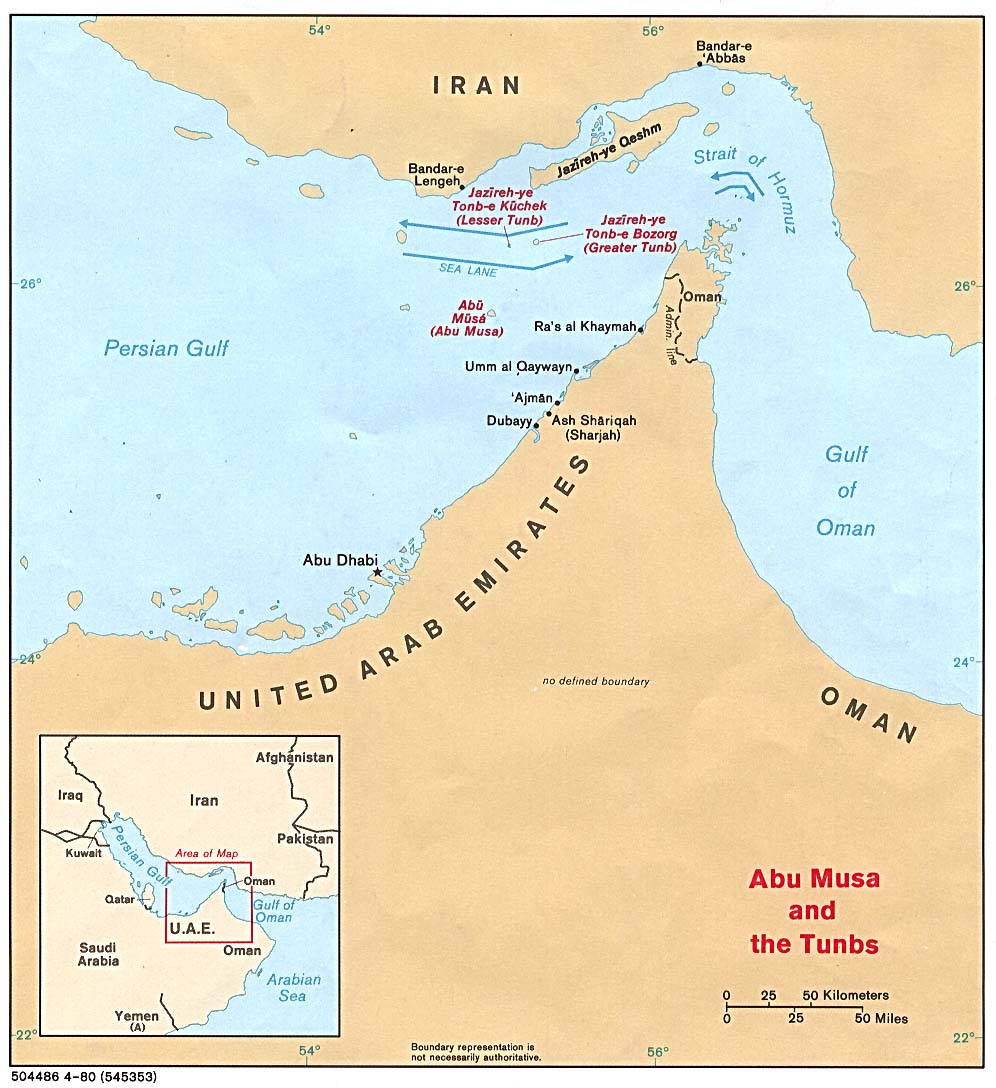
Triggering a War Pretext Incident: Provoking Iran to “Throw the First Punch”
Is the Obama administration prepared to sacrifice one or more vessels of the Fifth Fleet, resulting in extensive casualties among soldiers and sailors, with a view to mustering public support for a war on Iran on the grounds of self-defense?
As documented by Richard Sanders, the strategy of triggering a war pretext incident has been used throughout American military history.
“Throughout history, war planners have used various forms of deception to trick their enemies. Because public support is so crucial to the process of initiating and waging war, the home population is also subject to deceitful stratagems. The creation of false excuses to justify going to war is a major first step in constructing public support for such deadly ventures. Perhaps the most common pretext for war is an apparently unprovoked enemy attack. Such attacks, however, are often fabricated, incited or deliberately allowed to occur. They are then exploited to arouse widespread public sympathy for the victims, demonize the attackers and build mass support for military “retaliation.”
Like schoolyard bullies who shout ‘He hit me first!’, war planners know that it is irrelevant whether the opponent really did ‘throw the first punch.’ As long as it can be made to appear that the attack was unprovoked, the bully receives license to ‘respond’ with force. Bullies and war planners are experts at taunting, teasing and threatening their opponents. If the enemy cannot be goaded into ‘firing the first shot,’ it is easy enough to lie about what happened. Sometimes, that is sufficient to rationalize a schoolyard beating or a genocidal war.
Such trickery has probably been employed by every military power throughout history. During the Roman empire, “the cause for war” — casus belli — was often invented to conceal the real reasons for war. Over the millennia, although weapons and battle strategies have changed greatly, the deceitful strategem of using pretext incidents to ignite war has remained remarkably consistent. (See How to Start a War: The American Use of War Pretext Incidents. Global research, January 9, 2012)
Pearl Harbor stands out as the casus belli, the pretext and justification for America’s entry into World War II.
President Roosevelt knew that Pearl Harbor was going to be attacked by Japan and did nothing to prevent it. At a November 25 1941 meeting of FDR’s war council, “Secretary of War Henry Stimson’s notes speak of the prevailing consensus: ‘The question was how we should maneuver them [the Japanese] into … firing the first shot without allowing too much danger to ourselves.’” (See Patrick Buchanan, Did FDR Provoke Pearl Harbor? Global Research, December 7, 2011).

In the wake of the attack, America was beating the drums of war, while also concealing the fact that “the FDR administration knew, but failed to act”.
“A massive cover-up followed Pearl Harbor a few days later, … when the Chief of Staff ordered a lid put on the affair. ‘Gentlemen,’ he told half a dozen officers, ‘this goes to the grave with us.’” (John Toland, Infamy: Pearl Harbor and its Aftermath, Doubleday, 1982, p. 321).
According to Professor Francis Boyle with reference to the ongoing showdown between the US Navy and Iran in the Persian Gulf:: “Once again, it looks to me like what FDR did in 1941 when he sacrificed the Pacific Fleet and its men at Pearl Harbor—except for the carriers—in order to get the USA into World War II despite the fervent desire of the American People and Congress to stay out. Déjà vu all over again. Back to the Future ” (Francis Boyle, January 13, 2011, email communication to author)
In contrast to the events of 1941, the US Congress in 2012 is broadly supportive of waging a war on Iran and the American people are, as a result of media disinformation, largely unaware of the devastating implications of a US-Israeli attack. .
Thematic Justifications: Demonizing the Enemy
Apart from the “incident” whereby the enemy is incited to “throw the first punch”, “thematic justifications” are used to demonize the enemy and justify a casus belli. WMD and regime change in the case of Iraq (2003), Al Qaeda and the 9/11 attacks in the case of Afghanistan (2001), “regime change” and “democratization” in the case of Libya (2011).
The thematic justifications to wage war on Iran include the following:
1. Iran is accused of developing a nuclear weapons program, 2. Iran is a “Rogue State” which defies the “international community” and constitutes a threat the Western World, 3. Iran wants “to wipe Israel off the map”, 4. Iran is responsible for supporting and abetting the 9/11 terrorist attacks, 5. Iran is an authoritarian and undemocratic country thereby justifying a “Responsibility to Protect” (R2P) intervention with a view to instating democracy.
Saudi Arabia and the Gulf States
In case of a war with Iran, NATO member states as well as NATO partners of the “Mediterranean Dialogue” including the Five GCC Gulf States, Saudi Arabia, Jordan would be involved.
Saudi Arabia and the Gulf States have a formidable weapons arsenal (Made in America), which would be used against Iran on behalf of the US led coalition. (see The Gulf Military Balance in 2010: An Overview | Center for Strategic and International Studies)
The US has more than 30 military bases and facilities including its naval base in Bahrain, US Central command (CENTCOM) headquarters in Qatar, not to mention its military installations in Pakistan, Turkey and Afghanistan (see map)
* US military base or facility surrounding Iran
From Washington’s standpoint, Saudi Arabia’s Royal Air Force is meant to act as a proxy for the USAF, operating on the principle of “interoperability”. Saudi Arabia’s Air Force is equipped with the most advanced combat planes including (among others) the Eurofighter Typhoons, Tornado IDS, F-15 and F-15E Eagle fighters. In October 2010, Washington announced its largest arms sale in US history, a $60.5 billion purchase by Saudi Arabia. These weapons although acquired by Saudi Arabia are de facto part of a US sponsored weapons arsenal, which is to be used in close coordination and consultation with the Pentagon.
It should, nonetheless, be emphasised that there is reluctance within the ruling Saudi and Gulf States elites, to actively participating in a regional war, which would inevitably lead to Iranian retaliatory aerial attacks.
Escalation: Towards a Broader Regional War
If aerial attacks were to be launched, Iran would retaliate with missile attacks directed against Israel as well as against US military facilities in the Persian Gulf, Iraq and Afghanistan.
Iran has an advanced Russian S 300 air defense system. It is equipped with medium and long range missile capabilities: The Shahab 3 and Sejjil missiles have a range of approximately 2,000 km, enabling them to strike targets in Israel. The Ghadr 1 has a range of 1,800 km. (See Haaretz, September 28, 2009, http://www.haaretz.com/news/background-how-big-is-iran-s-military-1.7084
The war with Iran would not be limited to aerial bombardments. A land war could follow with Turkey playing a strategic military role on behalf of the US-Israel led coalition.
Turkey’s ground forces are of the order of 500,000. Iran’s are of a similar order of magnitude: 465,000 regular forces, which would immediately be deployed in border areas with Iran and Syria as well as within Syria.
Iran’s Air Force and Navy personnel are respectively of the order of 52,000 and 28,000. The Revolutionary Guards, which constitute Iran’s elite forces, are of the order of 120,000. Moreover, Iran has a significant paramilitary force called the Basij. (see Table below)
The war would also overflow into Syria (which is an ally of Iran, Palestine, Lebanon and Jordan involving the participation of Syrian ground forces as well as Hezbollah, which effectively repealed Israel’s 2006 invasion of Lebanon. In recent developments, Iran has increased its military aid to Syria and Lebanon.
In turn, Russia has a naval base in Southern Syria and military cooperation agreements with both Syria and Iran, involving the presence of Russian military advisers.
Russia is deploying warships out of its naval base in Tartus including aircraft carrying missile cruiser Admiral Kuznetsov. “The deployment … follows the US move to station the George H.W. Bush Carrier Strike Group” off the Syrian coastline. (See M. K. Badrakumar, Russia deploying warships in Syria – Indian Punchline, November 21, 2011)

Russia’s Naval base in Tartus, Syria
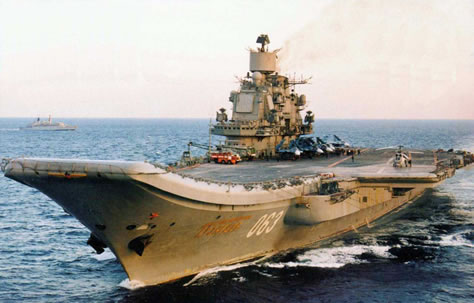
Admiral Kuznetsov aircraft carrier
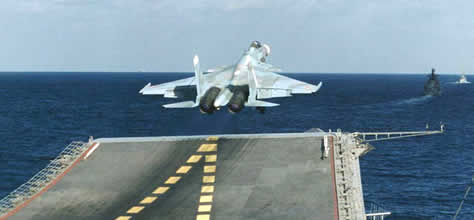
Su 33 take-off from aircraft carrier Admiral Kuznetsov in the Eastern Mediterranean
UN Security Council Resolution 1929 (June 2010) had imposed a sanctions regime on Iran which was conducive to a temporary freeze in military cooperation between Iran and Russia, as well as with China. In recent developments, it would appear that military cooperation has de facto resumed following the rebuff by both China and Russia of the December 31, 2011 economic sanctions regime imposed by Washington.
In a scenario of military escalation, Iranian troops and/or Special Forces would cross the border into Afghanistan and Iraq.
From the three existing war theaters: Afghanistan -Pakistan (Af-Pak), Iraq, Palestine, the onslaught of a war on Iran would lead to an integrated regional war.
The entire Middle East-Central Asian region extending from the Eastern Mediterranean to China’s Western frontier with Afghanistan and Pakistan would flare up, from the tip of the Arabian Peninsula to the Caspian Sea basin.
The Caucasus and Central Asia: Competing Military Alliances
What would be the involvement of America’s “partners” in the Caucasus, namely Georgia and Azerbaijan? (See Michel Chossudovsky, The Iran War Theater’s “Northern Front”: Azerbaijan and the US Sponsored War on Iran, Global Research, April 9, 2007).
In Azerbaijan, the government has recently distanced itself from Washington, and has turned down its participation in joint military exercises with the US.
The bilateral US-Azerbaijan strategic agreement is said to be stagnating:
“Baku’s desire to not to anger Moscow would seem to preclude any possibility of Azerbaijan hosting a US military facility….” (Azerbaijan: US Military Ties with Baku Are Stagnating – Experts | EurasiaNet.org, April 25, 2011).
In contrast, the Georgian government is directly supporting America’s war effort against Iran. In recent developments, the Pentagon is sponsoring the construction of makeshift US military hospitals in Georgia to be used in the eventuality of a war with Iran. ( Readies for War On Iran: US Builds Military Hospitals in Georgia, Global Research, January 10, 2012)
“These are 20-bed hospitals…It’s an American project. A big war between the US and Iran is beginning in the Persian Gulf. $5 billion was allocated for the construction of these 20-bed military hospitals,” Javelidze said in an interview with Georgian paper Kviris Kronika (News of the Week) … The construction is mainly paid from the American pocket. In addition, airports are being briskly built in Georgia… (Ibid)
What the military hospitals project conveys is that the Pentagon has already established detailed logistics pertaining to the transfer of wounded US servicemen from the Iran battlefield to nearby military hospitals in Georgia. These advanced preparations suggest that war plans are at a very advanced stage and that scenarios pertaining to military casualties have been established.
Military Alliances: The Shanghai Cooperation Organization and the CSTO
The countervailing military alliance to the US-NATO-Israel axis is the Shanghai Cooperation Organization (SCO) as well as the overlapping Collective Security Treaty Organization (CSTO). The SCO includes Kazakhstan, the People’s Republic of China, the Kyrgyz Republic, the Russian Federation, the Republic of Tajikistan and the Republic of Uzbekistan. The SCO includes seven former Soviet republics including Russia, Belarus, Armenia, Kazakhstan, Kyrgyzstan, Uzbekistan and Tajikistan. Iran has observer status in the SCO.
Uzbekistan withdrew from the NATO sponsored GUUAM military cooperation agreement. In 2005, it formally evicted the US from the Karshi-Khanabad air base, known as K2 (U.S. Evicted From Air Base In Uzbekistan, Washington Post, July 30, 2005).
Of significance, in the Kyrgyz Republic, the new elected President Almazbek Atambayev (November 2011) stated that he intends to close down the US military base at Manas when the lease expires. (Kyrgyzstan Says United States’ Manas Air Base Will Close – NYTimes.com, November, 1, 2011)
What these developments suggest is that the former Soviet republics of Central Asia have reaffirmed their relationship to Moscow, which in turn has led the consolidation of the SCO-CSTO military bloc.
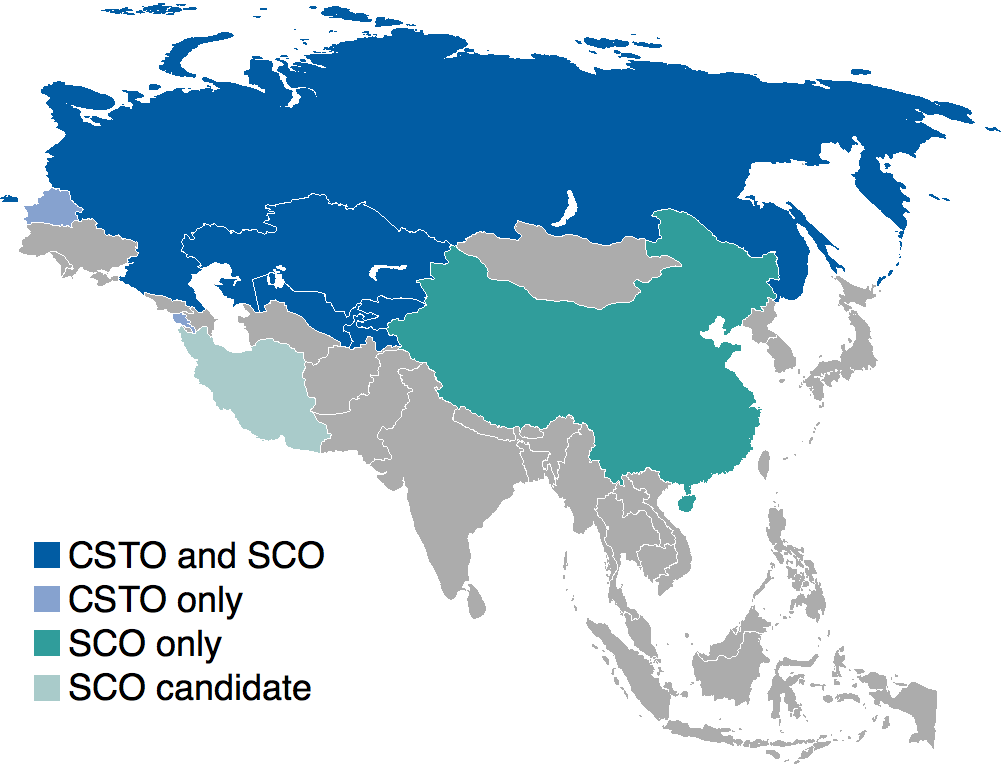
Global US Military Hegemony. Russia and China
The participation of Russia and China on the side of Iran is already de facto in view of prevailing military cooperation agreements. the transfer of weapons systems and technology to Iran, as well as the presence of Russian military advisers, training personnel, in both Iran and Syria. Moreover, Iran has Observer status in the SCO
Russia and China are fully aware that a war on Iran is a stepping stone towards a broader war. Both countries are targeted by the US and NATO. Russia is threatened on its border with the European Union, with US-NATO AMD targetted at major Russian cities. With the exception of its Northern frontier, China is surrounded by US military bases, from the Korean peninsula to the South China Sea.
Both China and Russia are perceived by Washington as a “Global Threat”. China has been the target of veiled threats by President Obama and Secretary of State Hillary Clinton. The recent National Defense Review announced by Defense Secretary Leon Panetta, envisages an expanded defense budget, with a view to containing Russia and China.
In recent development, Russia newly appointed Deputy Prime Minister Dmitri Rogozin has warned Washington and Brussels that “Should anything happen to Iran, should Iran get drawn into any political or military hardships, this will be a direct threat to our national security,”
Spiralling US Defense Spending: The Pentagon’s “Big Dog” Ideology
Washington’s objective is to establish global military dominance. While the “war on terrorism” and the containment of “rogue states” still constitute the official justification and driving force, China and Russia have been tagged in US military and National Security documents as potential enemies:
“… the U.S. military … is seeking to dissuade rising powers, such as China, from challenging U.S. military dominance.” (See Greg Jaffe, Rumsfeld details big military shift in new document, The Wall Street Journal, 11 March 2005)
How does Washington intend to reach its goal of global military hegemony?
Through spiralling defense spending and the continued growth of the US weapons industry, requiring a massive compression of all categories of government expenditure.
Implemented at the crossroads of the most serious economic crisis in American history, the ongoing increase in defense spending feeds this new undeclared arms race with China and Russia, with vast amounts of tax dollars channelled to America’s defense contractors.
“The stated objective is to make the process of developing advanced weapons systems “so expensive”, that no other power on earth including China and Russia will able to compete or challenge “the Big Dog”, without jeopardizing its civilian economy” Michel Chossudovsky, New Undeclared Arms Race:, Global Research, March 17, 2005)
This “Big Dog” ideology, a term coined by the Pentagon, is a precondition for the “Globalization of War”. It is a diabolical agenda of enhancing America’s killing machine by dismantling social programs and impoverishing people across the US.
“[A]t the core of this strategy is the belief that the US must maintain such a large lead in crucial [military] technologies that growing powers [ Russia, China, Iran] will conclude that it is too expensive for these countries to even think about trying to run with the big dog. They will realize that it is not worth sacrificing their economic growth, said one defense consultant who was hired to draft sections of the document.” (Greg Jaffe, Rumsfeld details big military shift in new document, The Wall Street Journal, March 11, 2005)
TABLE 1 THE ISLAMIC REPUBLIC OF IRAN: MILITARY CAPABILITIES
Total Population: 77,891,220 [2011]
Available Manpower: 46,247,556 [2011]
Fit for Military Service: 39,556,497 [2011]
Of Military Age: 1,392,483 [2011]
Active Military: 545,000 [2011]
Active Reserve: 650,000 [2011]
LAND ARMY
Total Land Weapons: 12,393
Tanks: 1,793 [2011]
Armoured Personnel Carrier/Infantry Fighting Vehicles (APC/IFV): 1,560 [2011]
Towed Artillery: 1,575 [2011]
SPGs: 865 [2011]
MLRSs: 200 [2011]
Mortars: 5,000 [2011]
Anti Tank (AT) Weapons: 1,400 [2011]
Anti-Aerial (AA) Weapons: 1,701 [2011]
Logistical Vehicles: 12,000
AIR POWER
Total Aircraft: 1,030 [2011]
Helicopters: 357 [2011]
Serviceable Airports: 319 [2011]
NAVAL POWER
Total Navy Ships: 261
Merchant Marine Strength: 74 [2011]
Major Ports & Terminals: 3 Aircraft Carriers: 0 [2011]
Destroyers: 3 [2011]
Submarines: 19 [2011]
Frigates: 5 [2011]
Patrol Craft: 198 [2011]
Mine Warfare Craft: 7 [2011]
Amphibious Assault Craft: 26 [2011]
SOURCES:
http://www.iraniandefence.com/iran-army/
and http://www.globalfirepower.com/country-military-strength-detail.asp?country_id=Iran
Michel Chossudovsky is an award-winning author, Professor of Economics (Emeritus) at the University of Ottawa. He is the Founder and Director of the Centre for Research on Globalization (CRG), Montreal and Editor of the globalresearch.ca website. He is the author of The Globalization of Poverty and The New World Order (2003) and America’s “War on Terrorism”(2005). His most recent book is entitled Towards a World War III Scenario: The Dangers of Nuclear War (2011). He has taught as Visiting Professor at universities in Western Europe, South East Asia and Latin America, acted as an adviser to governments of developing countries and as a consultant for the several international organizations. Prof. Chossudovsky is a signatory of the Kuala Lumpur declaration to criminalize war and recipient of the Human Rights Prize of the Society for the Protection of Civil Rights and Human Dignity (GBM), Berlin, Germany. He is also a contributor to the Encyclopaedia Britannica. His writings have been published in more than twenty languages.
Source:
http://globalresearch.ca/index.php?context=va&aid=28652

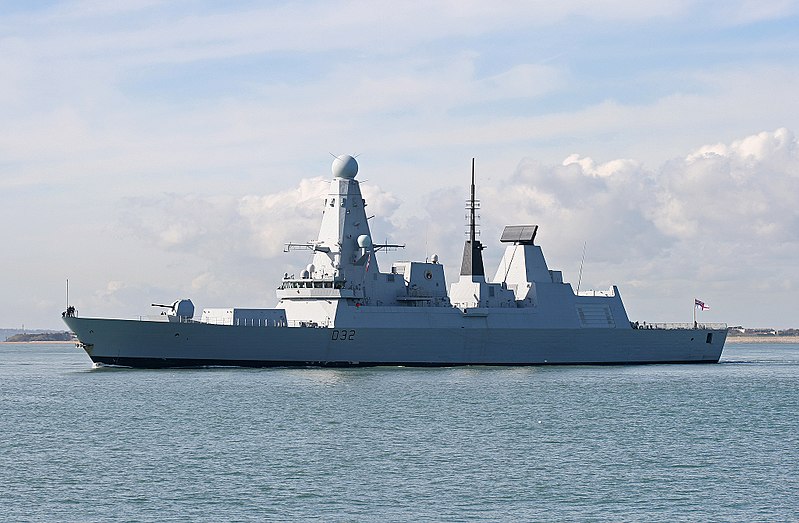

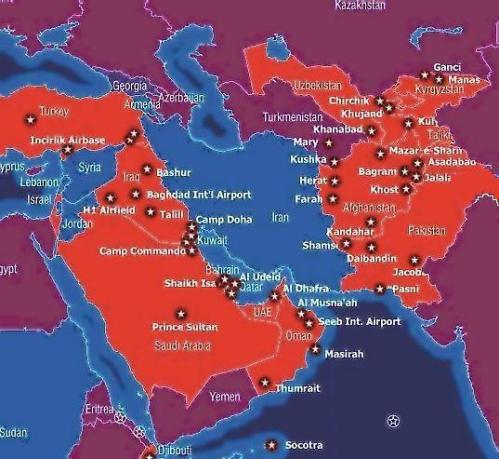



disorderisti
The neocons are at it again. Emboldened by their success in leading America into war with Iraq, they’re now setting their sights on Iran. Every day now the mainstream media seems to produce another provocative report. War Games. Hormuz. Oil. Nukes.
Remember when Cheney and Rumsfeld each pointed to news headlines as proof that Saddam had weapons of mass destruction? Remember how that was enough to justify a decade long bloodbath in Iraq? Remember when we said we wouldn’t be fooled like that in the future?
Think again.
Read this Al-Jazeera piece about the American media’s march to war and then send an email to the New York Times!
http://www.aljazeera.com/indepth/opinion/2012/01/20121872656281735.html